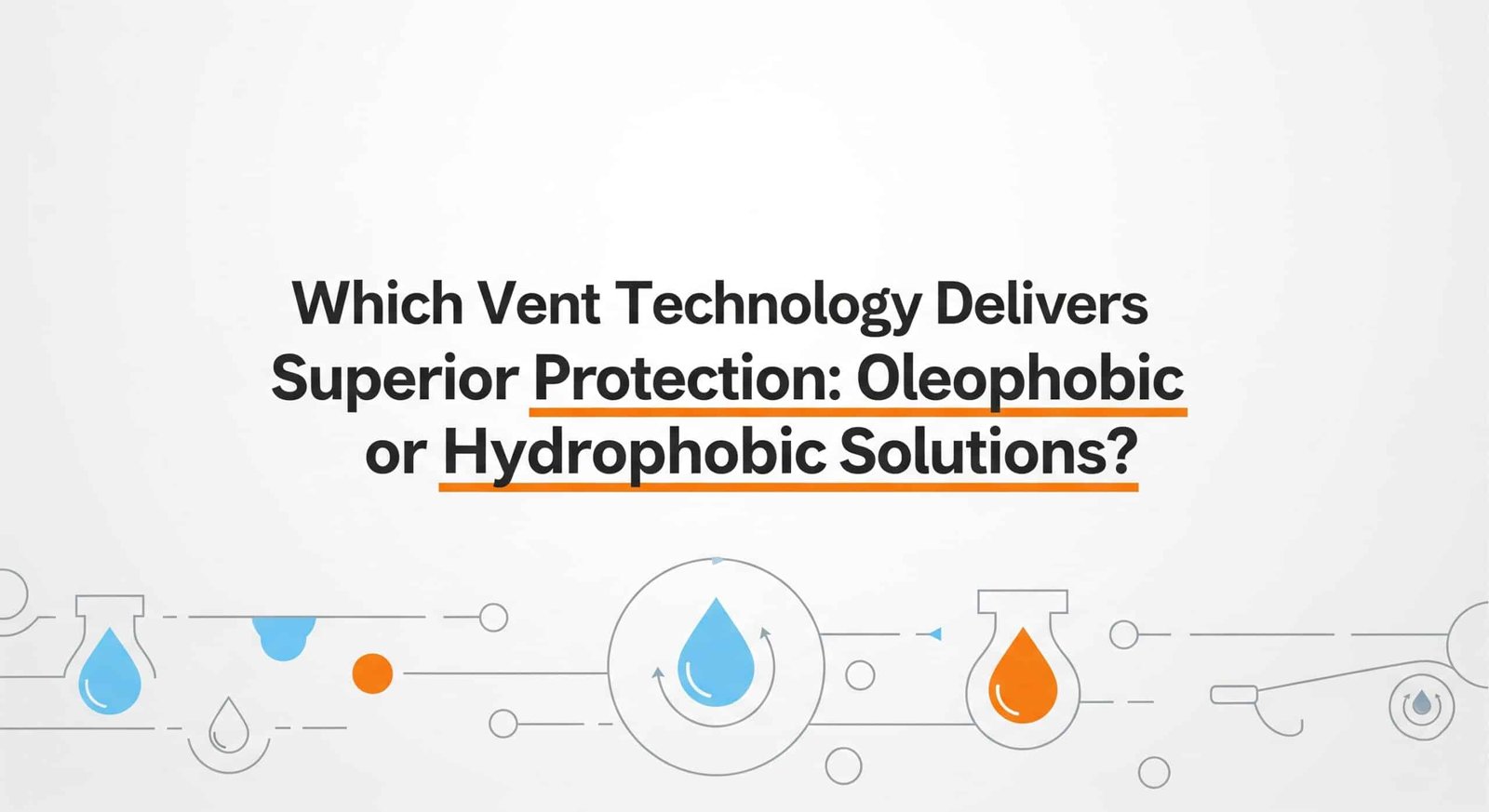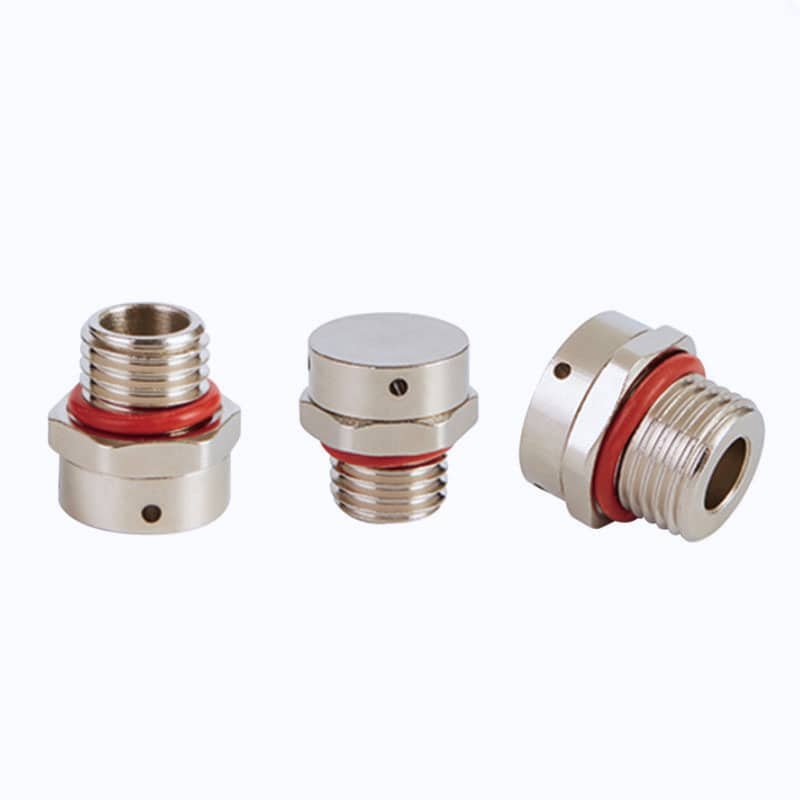Industrial equipment failures from contamination cost manufacturers millions annually, yet many facilities still use inadequate venting solutions that allow oil, water, and debris infiltration. The wrong vent technology can destroy expensive pneumatic systems within months, leading to catastrophic downtime and repair costs. Oleophobic1 vents repel both oil and water while allowing air flow, making them superior to hydrophobic2-only solutions for industrial applications where oil contamination is present alongside moisture.
Last week, I received an urgent call from Robert, a maintenance engineer at a steel processing plant in Pennsylvania, whose rodless cylinder systems were failing every few months due to oil mist contamination that standard hydrophobic vents couldn’t prevent.
Table of Contents
- What’s the Key Difference Between Oleophobic and Hydrophobic Vent Technologies?
- How Do You Determine Which Vent Type Your Application Requires?
- What Are the Performance Trade-offs Between These Vent Technologies?
- Why Choose Bepto’s Advanced Vent Solutions for Critical Applications?
What’s the Key Difference Between Oleophobic and Hydrophobic Vent Technologies?
Understanding the fundamental differences between these technologies is crucial for selecting the right protection system for your specific industrial environment.
Hydrophobic vents repel water only using surface tension3 properties, while oleophobic vents actively repel both water and oil-based contaminants through advanced membrane chemistry, providing comprehensive protection in mixed-contamination environments.

Hydrophobic Technology Fundamentals
Basic Operating Principle
Hydrophobic vents utilize membrane materials with high water contact angles4 (typically >120°) that cause water droplets to bead and roll off the surface rather than penetrating through the pores.
Key Characteristics
- Material basis: ePTFE (expanded polytetrafluoroethylene)5 membranes
- Pore structure: Microporous with 0.1-0.5 micron openings
- Water resistance: Excellent against aqueous solutions
- Oil vulnerability: Limited protection against hydrocarbon contamination
Oleophobic Technology Advantages
Advanced Chemical Resistance
Oleophobic membranes feature specialized surface treatments that create low surface energy barriers against both polar and non-polar liquids.
Superior Protection Scope
- Dual repellency: Effective against water AND oil-based contaminants
- Chemical compatibility: Resistant to hydraulic fluids, cutting oils, lubricants
- Membrane durability: Enhanced resistance to chemical degradation
- Application versatility: Suitable for harsh industrial environments
Performance Comparison Table
| Feature | Hydrophobic Vents | Oleophobic Vents |
|---|---|---|
| Water Protection | Excellent | Excellent |
| Oil Protection | Poor | Excellent |
| Chemical Resistance | Limited | Superior |
| Cost | Lower | Higher |
| Lifespan | 1-2 years | 3-5 years |
| Air Flow Rate | High | Moderate-High |
How Do You Determine Which Vent Type Your Application Requires?
Proper vent selection requires careful analysis of your operating environment, contamination sources, and performance requirements to ensure optimal protection.
Assess your contamination sources: choose hydrophobic vents for water-only environments, but select oleophobic solutions when oil mist, hydraulic fluids, or cutting oils are present in your facility’s atmosphere.
Environmental Assessment Criteria
Contamination Source Analysis
- Water-based threats: Humidity, condensation, washdown procedures
- Oil-based hazards: Machining operations, hydraulic systems, lubrication mist
- Chemical exposure: Solvents, cleaning agents, process chemicals
- Particulate matter: Dust, metal shavings, airborne debris
Application-Specific Requirements
Industrial Environment Categories
Clean Manufacturing Environments
- Recommended: Hydrophobic vents sufficient
- Examples: Electronics assembly, food packaging, pharmaceutical
- Contamination: Primarily moisture and light particulates
- Cost consideration: Lower-cost solution appropriate
Heavy Industrial Applications
- Recommended: Oleophobic vents essential
- Examples: Metalworking, automotive manufacturing, chemical processing
- Contamination: Oil mist, hydraulic fluids, cutting oils, coolants
- Protection priority: Comprehensive contamination resistance required
Maria, who manages a packaging machinery company in Germany, initially tried to save costs by using standard hydrophobic vents in her oil-rich production environment. After experiencing three rodless cylinder failures in six months, she switched to our oleophobic solutions and hasn’t had a single contamination-related failure in over two years. 🛡️
Selection Decision Matrix
| Environment Type | Primary Contaminants | Recommended Solution | Expected Lifespan |
|---|---|---|---|
| Clean Room | Water vapor, light dust | Hydrophobic | 18-24 months |
| General Manufacturing | Water, light oils | Oleophobic | 36-48 months |
| Heavy Industry | Oil mist, hydraulics | Oleophobic | 48-60 months |
| Chemical Processing | Mixed chemicals | Specialized Oleophobic | 24-36 months |
What Are the Performance Trade-offs Between These Vent Technologies?
Every vent technology involves balancing protection level, air flow capacity, cost, and maintenance requirements to optimize system performance.
Oleophobic vents typically cost 40-60% more initially but deliver 2-3x longer service life and superior protection, making them more cost-effective in contaminated environments despite higher upfront investment.
Cost-Benefit Analysis
Initial Investment Comparison
- Hydrophobic vents: $15-25 per unit
- Oleophobic vents: $25-40 per unit
- Installation costs: Identical for both technologies
- System integration: No modifications required
Long-term Operating Costs
Total Cost of Ownership
Hydrophobic Vent Economics
- Replacement frequency: Every 12-18 months in oil environments
- Contamination failures: Higher risk of system damage
- Maintenance labor: More frequent service intervals
- Downtime costs: Potential for unexpected failures
Oleophobic Vent Value Proposition
- Extended service life: 3-5 years typical operation
- Reduced failures: Superior contamination resistance
- Lower maintenance: Fewer replacement cycles
- System protection: Enhanced equipment longevity
Performance Metrics Comparison
| Performance Factor | Hydrophobic | Oleophobic | Advantage |
|---|---|---|---|
| Air Flow (L/min) | 85-95 | 75-85 | Hydrophobic |
| Water Resistance | Excellent | Excellent | Equal |
| Oil Resistance | Poor | Excellent | Oleophobic |
| Service Life | 1-2 years | 3-5 years | Oleophobic |
| Total Cost (5 years) | $75-125 | $50-80 | Oleophobic |
James, a plant engineer at an automotive facility in Michigan, calculated that switching to oleophobic vents reduced his annual vent-related maintenance costs by 65% while eliminating contamination-induced cylinder failures entirely.
Why Choose Bepto’s Advanced Vent Solutions for Critical Applications?
Our engineering expertise and quality manufacturing deliver superior vent technologies designed for reliable, long-term protection in the most demanding industrial environments.
Bepto’s oleophobic and hydrophobic vents feature precision-engineered membranes, comprehensive chemical resistance, and proven performance in over 10,000 installations worldwide – delivering 40% longer service life at competitive pricing.
Our Vent Technology Advantages
Advanced Membrane Engineering
- Precision manufacturing: Controlled pore structure for optimal performance
- Chemical resistance: Superior durability in harsh environments
- Quality testing: 100% pressure and flow verification
- Certification: ISO 9001 manufacturing standards
Comprehensive Product Range
- Hydrophobic solutions: Cost-effective water protection
- Oleophobic technology: Advanced dual-phase resistance
- Custom configurations: Tailored to specific applications
- Technical support: Expert application guidance
Bepto vs. OEM Comparison
| Feature | Bepto Solutions | OEM Alternatives |
|---|---|---|
| Performance | Equal or superior | Standard |
| Cost | 30-40% less | Premium pricing |
| Availability | 3-5 days | 2-6 weeks |
| Technical Support | Comprehensive | Limited |
| Customization | Available | Restricted |
| Warranty | 2-year standard | 1-year typical |
We’ve helped over 500 facilities optimize their vent protection systems, typically achieving 50-70% reduction in contamination-related failures while significantly reducing long-term operating costs. 🎯
Selecting the right vent technology – oleophobic for oil-contaminated environments, hydrophobic for water-only applications – ensures optimal protection and cost-effectiveness for your pneumatic systems.
FAQs About Oleophobic and Hydrophobic Vents
Q: Can I use hydrophobic vents in environments with occasional oil exposure?
A: Occasional light oil exposure may be acceptable, but regular oil mist or hydraulic fluid presence will quickly degrade hydrophobic membranes. Oleophobic vents provide better long-term reliability in mixed-contamination environments.
Q: Do oleophobic vents restrict air flow compared to hydrophobic alternatives?
A: Oleophobic vents typically have 10-15% lower air flow rates due to their advanced membrane structure, but this reduction rarely impacts pneumatic system performance. The trade-off for superior protection is usually worthwhile.
Q: How do I know when my vent needs replacement?
A: Monitor for reduced air flow, visible contamination on the membrane surface, or increased system cycling times. Most vents should be inspected every 6 months and replaced based on visual condition and performance metrics.
Q: Are oleophobic vents compatible with all pneumatic cylinder types?
A: Yes, both oleophobic and hydrophobic vents use standard threading and mounting configurations. They’re fully compatible with rodless cylinders, standard cylinders, and other pneumatic equipment from all major manufacturers.
Q: What’s the typical payback period for upgrading to oleophobic vents?
A: In oil-contaminated environments, oleophobic vents typically pay for themselves within 12-18 months through reduced replacement frequency, fewer contamination failures, and lower maintenance costs compared to hydrophobic alternatives.
-
Learn about the science of oleophobicity and the low surface energy properties that allow materials to repel oil. ↩
-
Explore the principles of hydrophobicity and why certain materials naturally repel water. ↩
-
Understand the physics of surface tension, the property of a liquid’s surface that allows it to resist an external force. ↩
-
Discover how contact angle is measured and used to quantify the wettability of a solid surface by a liquid, indicating its hydrophobic or oleophobic nature. ↩
-
Review the unique microporous structure, chemical inertness, and common industrial applications of expanded Polytetrafluoroethylene (ePTFE). ↩



